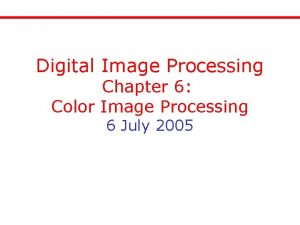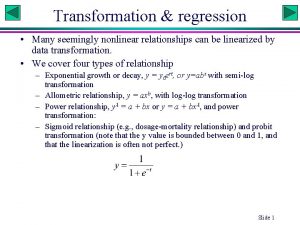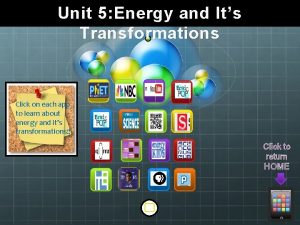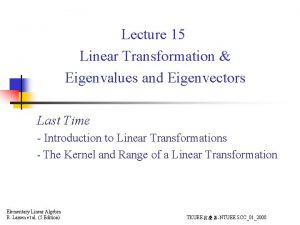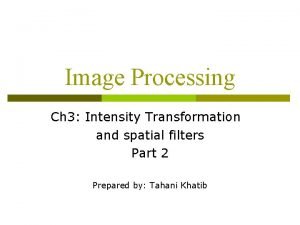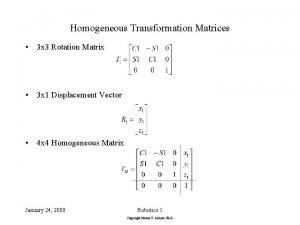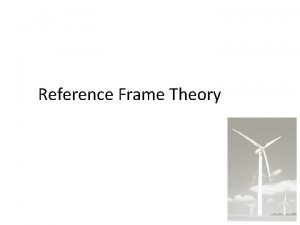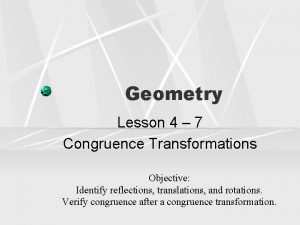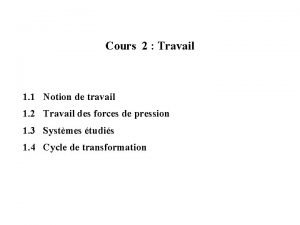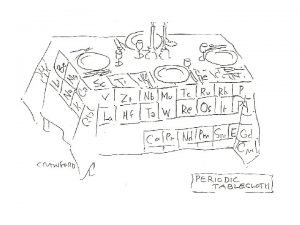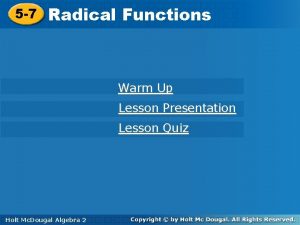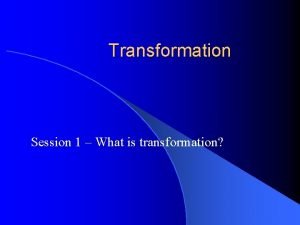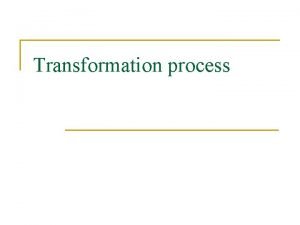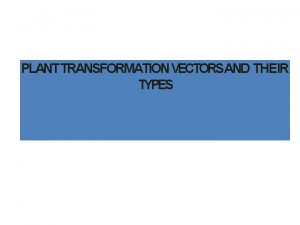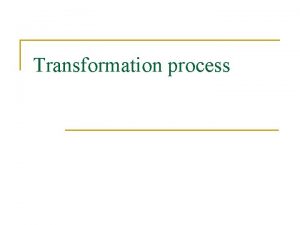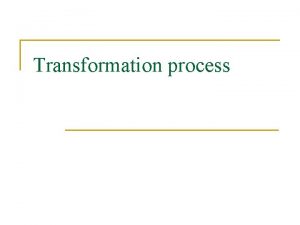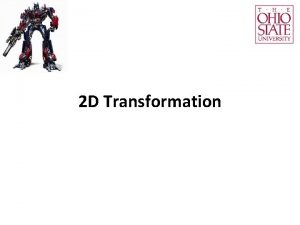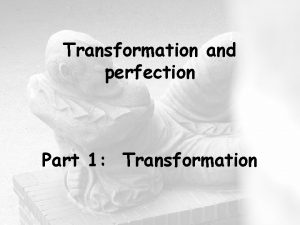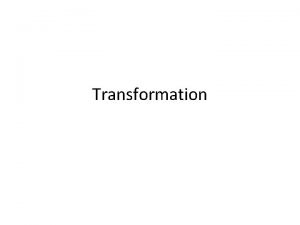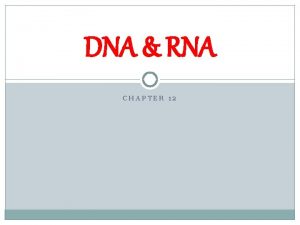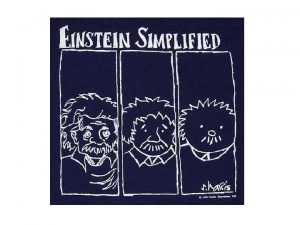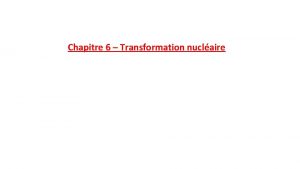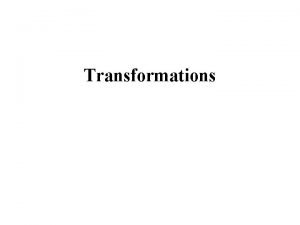3 D Transformation Transformation A transformation is an
















![Arbitrary Axis Rotation • Step 2. Establish [ TR ] x x axis y Arbitrary Axis Rotation • Step 2. Establish [ TR ] x x axis y](https://slidetodoc.com/presentation_image_h2/6ae3eb389ef5099d6841befed02c1d86/image-17.jpg)









![Example • Multiplying [TR]AB by the point matrix of the original cube Anil Verma, Example • Multiplying [TR]AB by the point matrix of the original cube Anil Verma,](https://slidetodoc.com/presentation_image_h2/6ae3eb389ef5099d6841befed02c1d86/image-27.jpg)


- Slides: 29

3 D Transformation

Transformation • A transformation is an operation that transforms or changes a shape. • There are several basic ways you can change a shape: – Translation (moving it) – Rotation (turning it round) – Scaling (making it bigger or smaller). – Shear (changing the main shape). – Reflection (mirroring the shape about axis). • Transforming an object means transforming all of its points Anil Verma, IOE Pulchowk

3 D Transformation • • Same as 2 D. Add z-axis and z-coordinate. Use 4 X 4 homogenous matrix. In part I, we discussed translation, rotation and scaling. Anil Verma, IOE Pulchowk

3 D Translation Anil Verma, IOE Pulchowk

3 D Scaling (relative to the origin point) • x, y and z values multiplied by scaling factors sx, sy and sz Anil Verma, IOE Pulchowk

3 D Scaling (relative to the origin point) Anil Verma, IOE Pulchowk

3 D Scaling (relative to fixed point) Fixed point Anil Verma, IOE Pulchowk

3 D Scaling (relative to fixed point) • Scaling with a Selected Fixed Position y z y x Original position y x z Translate y x z Scaling Anil Verma, IOE Pulchowk z x Inverse Translate

3 D Scaling (relative to fixed point) • for general scaling (relative to fixed point F) • where Anil Verma, IOE Pulchowk

3 D Rotation • Coordinate-Axes Rotations – X-axis rotation – Y-axis rotation – Z-axis rotation • General 3 D Rotations – Rotation about an axis that is parallel to one of the coordinate axes – Rotation about an arbitrary axis Anil Verma, IOE Pulchowk

3 D Rotation – (z-axis) • Rotating around the z axis: Anil Verma, IOE Pulchowk

3 D Rotation – (x-axis) • Rotation around the X axis: Anil Verma, IOE Pulchowk

3 D Rotation – (y-axis) • Rotation around the Y axis: Anil Verma, IOE Pulchowk

General 3 D Rotations • Rotation about an Axis that is Parallel to One of the Coordinate Axes – Translate the object so that the rotation axis coincides with the parallel coordinate axis – Perform the specified rotation about that axis – Translate the object so that the rotation axis is moved back to its original position Anil Verma, IOE Pulchowk

General 3 D Rotations • Rotation about an Arbitrary Axis Basic Idea y T (x 2, y 2, z 2) R (x 1, y 1, z 1) R-1 x T-1 1. Translate (x 1, y 1, z 1) to the origin 2. Rotate (x’ 2, y’ 2, z’ 2) on to the z axis 3. Rotate the object around the z-axis 4. Rotate the axis to the original orientation 5. Translate the rotation axis to the original position z Anil Verma, IOE Pulchowk

Arbitrary Axis Rotation • Step 1. Translation y (x 2, y 2, z 2) (x 1, y 1, z 1) x z Anil Verma, IOE Pulchowk
![Arbitrary Axis Rotation Step 2 Establish TR x x axis y Arbitrary Axis Rotation • Step 2. Establish [ TR ] x x axis y](https://slidetodoc.com/presentation_image_h2/6ae3eb389ef5099d6841befed02c1d86/image-17.jpg)
Arbitrary Axis Rotation • Step 2. Establish [ TR ] x x axis y (0, b, c) Projected Point (a, b, c) x z Rotated Point Anil Verma, IOE Pulchowk

Arbitrary Axis Rotation • Step 3. Rotate about y axis by y (a, b, c) Projected Point l d x (a, 0, d) z Rotated Point Anil Verma, IOE Pulchowk

Arbitrary Axis Rotation • Step 4. Rotate about z axis by the desired angle y l x z Anil Verma, IOE Pulchowk

Arbitrary Axis Rotation • Step 5. Apply the reverse transformation to place the axis back in its initial position y l l x z Anil Verma, IOE Pulchowk

Example Ex) Find the new coordinates of a unit cube 90º-rotated about an axis defined by its endpoints A(2, 1, 0) and B(3, 3, 1). A Unit Cube Anil Verma, IOE Pulchowk

Example • Step 1. Translate point A to the origin y B’(1, 2, 1) A’(0, 0, 0) x z Anil Verma, IOE Pulchowk

Example • Step 2. Rotate axis A’B’ about the x axis by and angle , until it lies on the xz plane. y Projected point (0, 2, 1) z B’(1, 2, 1) l x B”(1, 0, 5) Anil Verma, IOE Pulchowk

Example • Step 3. Rotate axis A’B’’ about the y axis by and angle , until it coincides with the z axis. y (0, 0, 6) l x B”(1, 0, 5) z Anil Verma, IOE Pulchowk

Example • Step 4. Rotate the cube 90° about the z axis Finally, the concatenated rotation matrix about the arbitrary axis AB becomes, Anil Verma, IOE Pulchowk

Example Anil Verma, IOE Pulchowk
![Example Multiplying TRAB by the point matrix of the original cube Anil Verma Example • Multiplying [TR]AB by the point matrix of the original cube Anil Verma,](https://slidetodoc.com/presentation_image_h2/6ae3eb389ef5099d6841befed02c1d86/image-27.jpg)
Example • Multiplying [TR]AB by the point matrix of the original cube Anil Verma, IOE Pulchowk

3 D Reflection • Reflection Relative to the xy Plane y y z z x x • [Do also Reflection Relative to the yz, zx Plane. . . ] Anil Verma, IOE Pulchowk

3 D Shear • Z-axis shear • Where a and b are the shear factors for x and y respectively. • Do, X-axis and Y-axis shear. Anil Verma, IOE Pulchowk
 Automation
Automation Mimic octopus kingdom
Mimic octopus kingdom Chromatic light
Chromatic light Bilinear transformation formula
Bilinear transformation formula Left and right transformations
Left and right transformations Nonlinear transformation regression
Nonlinear transformation regression Ftp discovery
Ftp discovery Study jams kinetic energy
Study jams kinetic energy Eigenspace
Eigenspace Contract matrix template
Contract matrix template Energy in science
Energy in science Intensity transformation in digital image processing
Intensity transformation in digital image processing Transformationsatlas ig metall
Transformationsatlas ig metall Homogenous transformation matrices
Homogenous transformation matrices Total transformation
Total transformation Evaluating organizational change
Evaluating organizational change Self adjoint transformation
Self adjoint transformation Dqo transformation
Dqo transformation Vicarious transformation
Vicarious transformation After a congruence transformation
After a congruence transformation Transform plasmid
Transform plasmid Spatial data transformation
Spatial data transformation Pv=cte
Pv=cte Radius of gyration
Radius of gyration Imperative sentence
Imperative sentence Transformation of data into information is called
Transformation of data into information is called 5-7 practice b radical functions answers
5-7 practice b radical functions answers Marginal rate of transformation
Marginal rate of transformation Transformation des pronoms au discours indirect
Transformation des pronoms au discours indirect Berapa banyak kontrol transformation dalam 3d
Berapa banyak kontrol transformation dalam 3d


